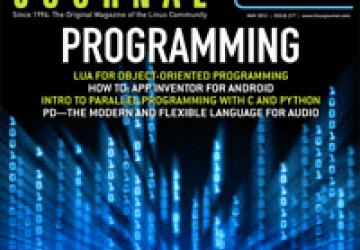May 2012 Issue of Linux Journal: Programming

Rubies, Pythons and Perls!
It may sound like a new Indiana Jones movie or possibly a cheesy platform-style video game from the 1990s, but the title of this column actually refers to our focus this month—programming! Not that there's anything wrong with daring adventures in remote locations, it's just that all the red tape can be overwhelming. You know that somewhere there was a college intern filing environmental impact study reports, negotiating work visas for multi-country searches and adding venomous predator riders on the insurance policies. Dr Jones just grabbed his hat and found the treasure!
Here in the real world, we prefer to create our own treasures. That's where this issue comes into play. Reuven M. Lerner is actually a bit of a rebel this month, and in an ironic twist, he focuses on Web design frameworks. The worlds of Web design and programming certainly overlap, so we'll give him a pass. Dave Taylor wraps up his Words With Friends series by demonstrating how to calculate word point values. Dave's articles always are fun for me, because scripting is the only sort of programming I ever do (usually out of sysadmin need), and watching him create stuff that I understand is fun.
Kyle and I are system administrators by trade, so it's not a surprise that our columns this month show it. Kyle describes how to use iftop, which is like the monitoring tool top, except for bandwidth usage. If you are struggling to find where all your bandwidth is going, iftop can be invaluable, and in his article, you'll learn how to use it. For my column, it's quite clear where the bandwidth is going—to the thin clients! This month, I finish my three-part series on LTSP and discuss how to scale your thin-client environment. As with most complex problems, there isn't a single solution to LTSP scaling. I talk about a handful of methods and help you choose the best option for your environment.
I'm sure you're thinking, "I thought this was the programming issue!" Rest assured, it is. Alejandro Segovia explores Lua, a multiparadigm programming language. No, he doesn't take us to a Luau, with grass skirts and coconuts, but in his words, he "presents a reusable mechanism through which you can implement an object-oriented model using Lua's built-in constructs." On his heels, Amit Saha follows with a great article on using App Inventor to program for Android. With its drag-and-drop interface, App Inventor nips at the learning curve a bit for Android programming. Whether you want to create a fancy GUI application or a service that runs in the background, Amit's article will be very useful.
Dave Phillips introduces Pure Data (Pd), which is a graphic patching environment for audio production. If that sounds confusing, it's a bit like an old modular patching synthesizer on steroids. If even that sounds confusing, you should read the article. Dave discusses using Pd to program audio. It's pretty cool stuff, and you won't want to miss it.
Amit is back for a second time with an article on parallel programming. It seems everything from pocket watches to Space Shuttles (oh, how we miss Space Shuttles...) have multicore processors, but not all programs take advantage of them. Amit shows how to parallel program in Python and C. Because every modern CPU has more than one core, it makes sense to understand how parallel processing works.
Every programmer needs reliable hardware on which to run their programs. We included Florian Hass' article on highly available iSCSI storage this month, because even the best code will fail if the server fails. Florian shows how to use DRBD and Pacemaker to keep iSCSI available even when systems fail. It's a great read for anyone concerned with reliability and uptime, and aren't we all concerned about that?
We also have the full gamut of Linux Journal goodies this month. I review the ZaReason Valta X79, we have a slew of new product announcements, and we have more tips and tricks than you can shake a stick at. So put on your leather fedora, grab a whip and start on your programming adventure! We'll sit back and worry about all the red tape. Try to avoid venomous spiders though; our "adventure insurance" doesn't cover that.
Available to Subscribers: May 1










